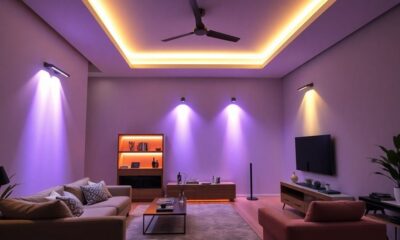Home Decor
Exploring Faux Myrtle Topiaries
Navigating the world of artificial myrtle topiaries reveals a treasure trove of stylish, low-maintenance options for elevating any indoor or outdoor space.
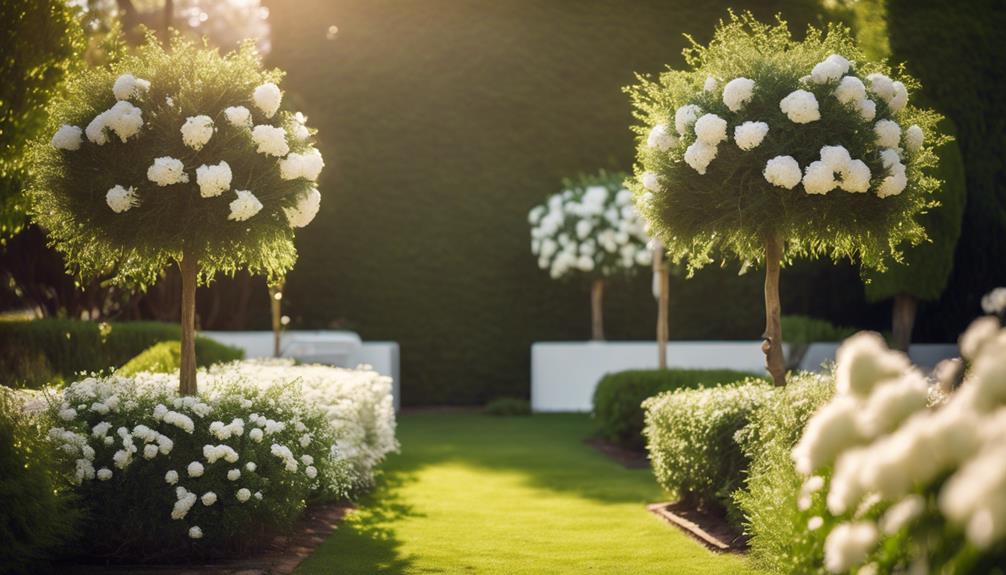
When you're looking for a low-maintenance way to add a touch of elegance and sophistication to your indoor or outdoor space, faux myrtle topiaries offer a convenient and cost-effective alternative to their high-maintenance real counterparts. With a rich history dating back to ancient Roman and Greek cultures, myrtle topiaries have symbolized love, peace, and prosperity for centuries. Today, faux options require zero maintenance, are cost-effective, and durable, making them a versatile and stylish choice for any setting. As you explore the world of faux myrtle topiaries, you'll discover a range of styles, decorating ideas, and expert recommendations to elevate your space to the next level.
Key Takeaways
• Faux myrtle topiaries require zero maintenance, are cost-effective, and durable, making them a great alternative to real myrtle topiaries.
• They come in various styles, can withstand different environmental conditions, and thrive in different light and humidity levels.
• Faux topiaries are versatile in placement, requiring only occasional dusting for a lifelike appearance, and can be used indoors or outdoors.
• You can find faux myrtle topiaries online at retailers like Amazon, Etsy, and Wayfair, or in-store at specialty garden stores with knowledgeable staff.
• Top designers recommend incorporating faux myrtle topiaries into decorative vignettes or as standalone pieces to add elegance and sophistication to any room.
History of Myrtle Topiaries
As you explore the world of topiaries, you'll discover that myrtle topiaries have a rich history dating back to ancient times when they were prized for their aromatic leaves and ornamental value.
The use of myrtle in topiaries can be traced back to Roman and Greek cultures, where it symbolized love, peace, and prosperity. Myrtle topiaries gained popularity in Europe during the Renaissance era, often seen in elaborate garden designs of wealthy estates.
During this time, myrtle topiaries became a status symbol, showcasing the owner's wealth and sophistication. The Renaissance era's emphasis on classical culture and beauty led to the revival of ancient Greek and Roman gardening practices, which included the use of myrtle topiaries.
As a result, myrtle topiaries became an integral part of European gardening, adding a touch of elegance and sophistication to outdoor spaces.
Benefits of Faux Over Real
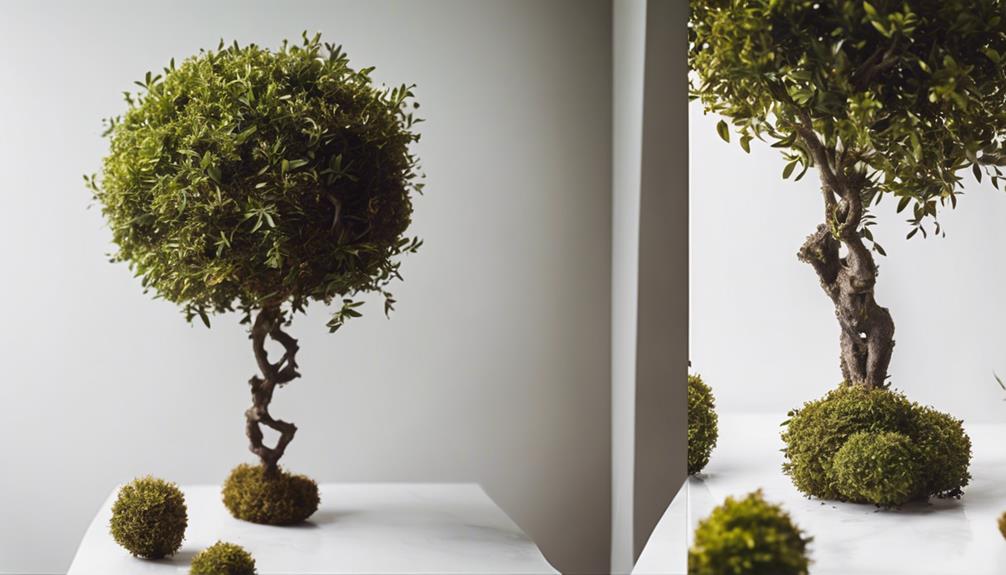
You'll find that opting for faux myrtle topiaries offers a multitude of benefits that make them a more practical and convenient choice compared to their real counterparts. Not only do they require zero maintenance, but they're also more cost-effective in the long run since they don't need regular watering, fertilizing, or pruning. This makes them an excellent option for busy individuals or those without a green thumb.
Here are just a few more advantages of choosing faux myrtle topiaries:
- They're durable and can withstand various environmental conditions without wilting or dying.
- They're versatile in placement, thriving in areas with low light or high humidity where real plants may struggle.
- They offer a realistic appearance with high-quality materials that closely resemble the look of real plants.
- They can be used in a variety of Home Decor settings, from modern to traditional, and can even be paired with essential oils for a unique sensory experience.
- They come in a range of styles, including the popular Single Ball design, making them a great addition to any room.
Topiary Care and Maintenance
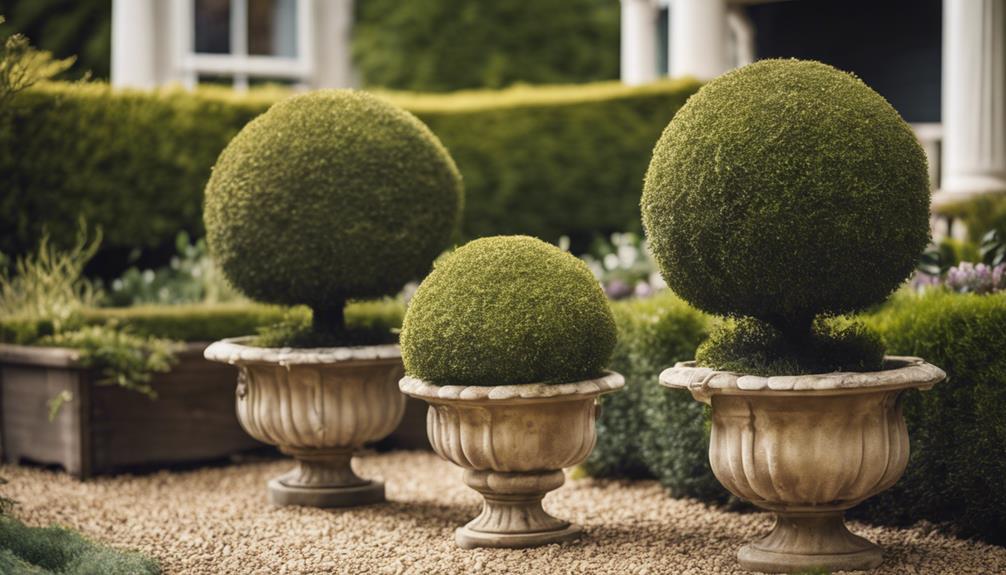
To keep your faux myrtle topiary looking its best, forget about the meticulous care required of its real counterpart, and simply dust it occasionally to maintain its lifelike appearance.
Since faux topiaries don't require the same level of maintenance, you can focus on enjoying its beauty without the hassle.
However, if you're interested in learning more about real myrtle topiary care, you can explore online resources, such as indoor plant forums, which offer valuable insights and tips from experienced growers.
You might even find affiliate links to helpful products or services that can aid in your plant care journey.
Popular Myrtle Topiary Styles
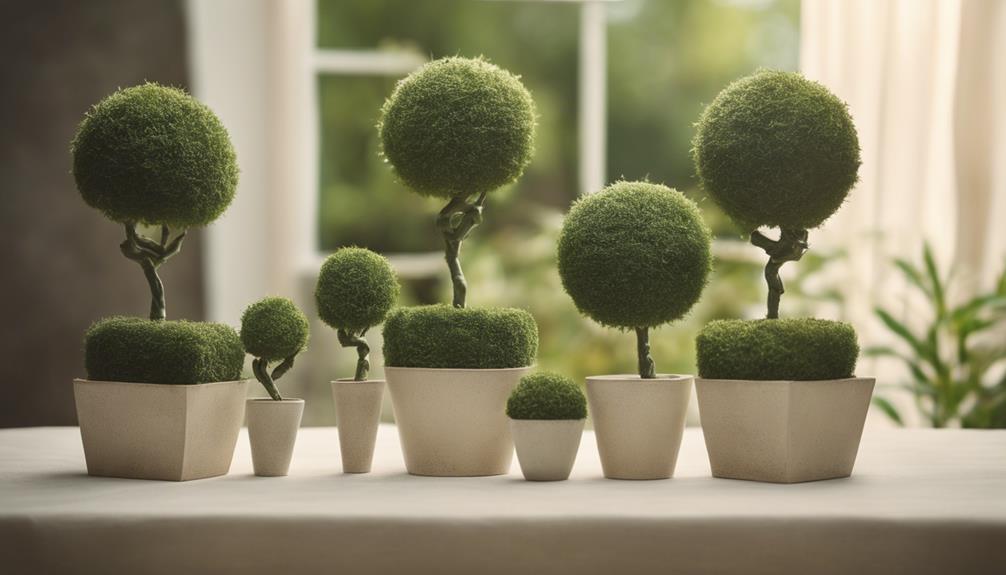
When it comes to decorating your space with faux myrtle topiaries, you have a range of stylish options to choose from, including single ball, tall 4 pack, and 6 pot arrangements that can add a touch of elegance to any room. These styles can be mixed and matched to create a unique look that reflects your personal taste.
Some popular myrtle topiary styles include:
- Single ball topiaries that provide a clean, minimalist look
- Tall 4 pack arrangements that add a touch of sophistication to any room
- 6 pot arrangements that create a lush, garden-like atmosphere
- Unique combinations of myrtle with other plants like rosemary or Westringia for a diverse garden look
- Custom designs that allow you to get creative with your decor
Decorating With Myrtle Topiaries

By incorporating myrtle topiaries into your decor, you can instantly elevate the ambiance of any room or outdoor space with a touch of natural elegance. These versatile decor elements can be used indoors or outdoors, adding a touch of greenery and sophistication to any space.
Myrtle topiaries come in various shapes, such as balls, spirals, or cones, allowing you to choose the perfect design to match your decor style. One of the best things about myrtle topiaries is that they require minimal maintenance, making them a low-fuss decorative accent that can last for a long time.
To add some extra flair, you can pair your myrtle topiary with a decorative pot or planter that complements your interior design. Whether you're looking to add some greenery to your living room, patio, or office, a myrtle topiary is a great way to bring in a touch of natural beauty and sophistication.
With their ease of care and versatility, it's no wonder myrtle topiaries are a popular choice for decorators and homeowners alike.
DIY Myrtle Topiary Projects
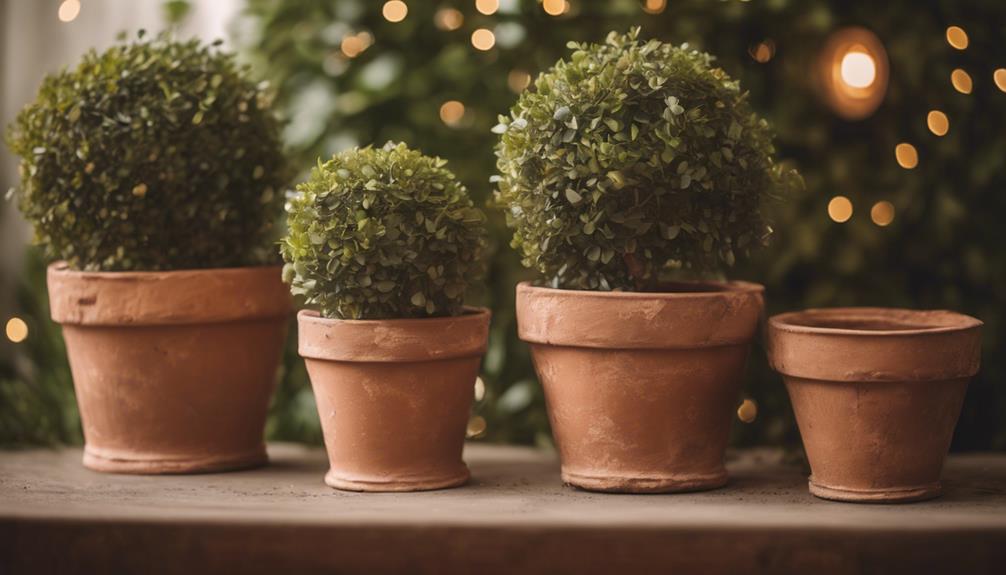
As you start on creating your own DIY myrtle topiary project, you'll want to begin by mastering the basics of topiary design, including selecting the right myrtle variety for your needs.
Next, you'll need to explore the art of decorating your topiary, where you can let your creativity shine through the use of ribbons, flowers, and other embellishments.
DIY Topiary Basics
You can create a beautiful DIY myrtle topiary by combining artificial myrtle foliage with a foam or wire topiary form, available at most craft stores. This DIY project is perfect for those who want to add a touch of greenery to their home without the hassle of caring for a live plant.
With faux myrtle topiaries, you can enjoy the beauty of a lush, verdant arrangement without worrying about watering, pruning, or providing sunlight.
Here are some benefits of creating your own DIY myrtle topiary:
- Low maintenance: Faux myrtle topiaries don't require regular watering or sunlight, making them perfect for busy people or those who tend to forget to care for their plants.
- Customizable: You can choose the shape, size, and color of your topiary to fit your home decor style and preferences.
- Year-round enjoyment: With a DIY myrtle topiary, you can enjoy the beauty of a lush arrangement all year round, without worrying about seasonal changes or plant care.
- Affordable: Craft stores offer affordable artificial myrtle foliage and topiary forms, making this DIY project a budget-friendly option.
- Flexibility: You can create a DIY myrtle topiary that fits your personal style, from modern to traditional, and everything in between.
Myrtle Selection Tips
Choosing the right myrtle plant is essential for creating a stunning DIY topiary. It's important to assess the foliage, shape, and size of the plant before beginning your project. You'll want to opt for a healthy myrtle plant with vibrant green leaves, as this will provide a lush, natural appearance.
Consider the shape of the plant as well – a well-shaped myrtle with a sturdy stem will create a visually appealing topiary. The size of the plant is also significant, as it will determine the height of your finished topiary. If you're looking for a fuller, more lush appearance, choose a myrtle plant with multiple branches.
Additionally, selecting a myrtle plant with a compact growth habit will make shaping and pruning easier, allowing you to achieve the desired shape for your DIY topiary. By taking these factors into consideration, you'll be well on your way to creating a beautiful, professional-looking topiary that will add a touch of elegance to any space.
Decorating Your Topiary
With your beautifully shaped myrtle plant in hand, it's time to get creative and turn it into a stunning decorative piece that reflects your personal style.
You can customize your DIY myrtle topiary project to fit your unique decor style, making it a one-of-a-kind addition to your home.
Here are some ideas to get you started:
- Use a decorative pot that complements your home's color scheme and style
- Add some decorative twigs, ribbons, or ornaments to give your topiary a personal touch
- Experiment with different shapes and sizes of foam cones to create a unique base for your myrtle stems
- Combine your myrtle stems with other greenery, like ferns or eucalyptus, for a lush and textured look
- Get creative with your stem arrangement – try an asymmetrical design or a spiral pattern to add visual interest
Choosing the Right Pot Size
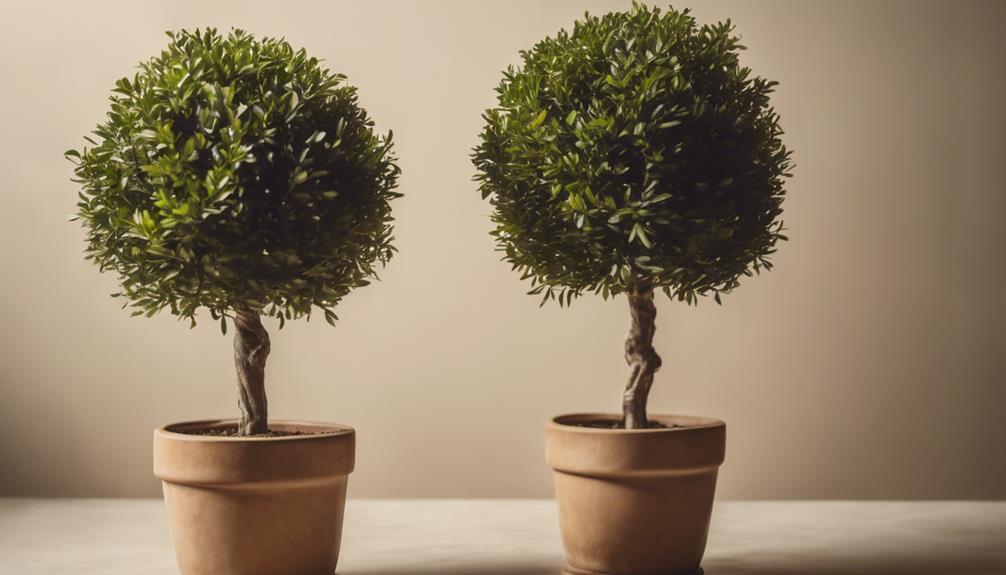
When selecting a pot for your faux myrtle topiary, its size plays an essential role in achieving the desired visual impact. You want to choose a pot that complements the height and overall aesthetic of your topiary. A general rule of thumb is to select a pot that's approximately 1/3 to 1/2 the height of your faux myrtle topiary. This proportion creates a visually appealing display.
Here's a guide to help you choose the right pot size:
| Faux Myrtle Height | Pot Height | Pot Material |
|---|---|---|
| 12-18 inches | 4-6 inches | Ceramic or Plastic |
| 18-24 inches | 6-8 inches | Ceramic or Wooden |
| 24-30 inches | 8-10 inches | Wooden or Heavy Ceramic |
| 30-36 inches | 10-12 inches | Heavy Ceramic or Stone |
| 36+ inches | 12+ inches | Stone or Large Ceramic |
Remember to opt for a heavier pot to provide stability for your faux myrtle topiary, especially if it's tall or top-heavy. Also, make sure the pot has proper drainage holes to prevent waterlogging and promote healthy faux myrtle growth. By choosing the right pot size, you'll enhance the overall visual impact of your display.
Myrtle Topiary Arrangement Ideas
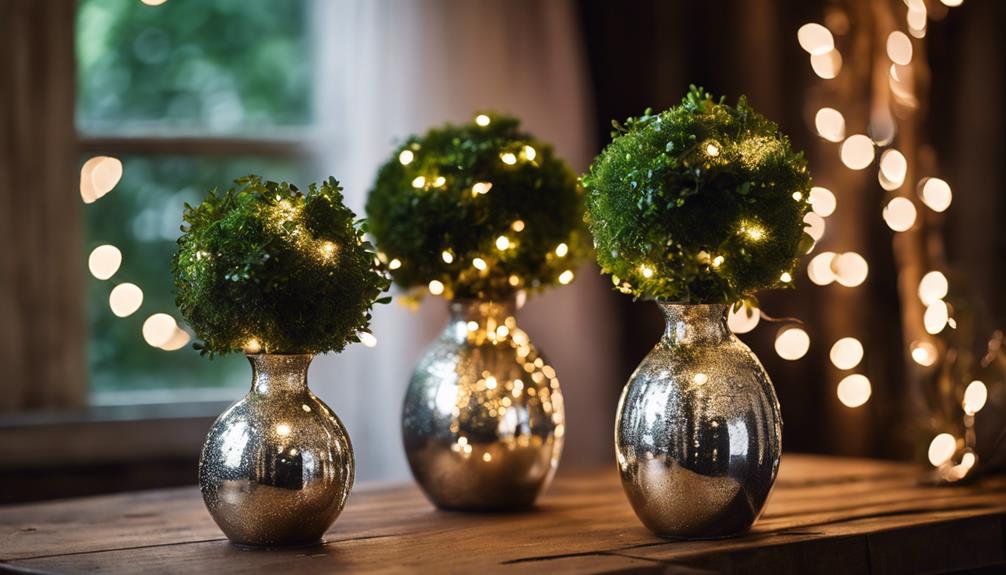
By mixing and matching different sizes and shapes of myrtle topiaries, you can create a unique and enchanting arrangement that adds visual interest to any space. This versatility allows you to get creative and experiment with various combinations to find the perfect look for your home or outdoor area.
Here are some ideas to get you started:
- Arrange myrtle topiaries in clusters of varying heights for a visually appealing display.
- Mix myrtle topiaries with other greenery like rosemary or boxwood to create a lush and dynamic arrangement.
- Place myrtle topiaries in decorative pots or urns to enhance their aesthetic appeal.
- Consider incorporating myrtle topiaries into outdoor spaces like patios or gardens for a touch of elegance.
- Experiment with different shapes and sizes of myrtle topiaries to create a personalized and distinctive arrangement.
Where to Buy Faux Myrtle Topiaries

As you search for the perfect faux myrtle topiary, you'll find that there are several avenues to explore when it comes to making a purchase.
You can turn to online marketplaces, which offer a wide range of options and often provide customer reviews to help inform your decision. Additionally, specialty garden stores and wholesale options exist, providing you with a variety of choices to suit your specific needs and preferences.
Online Marketplaces Available
You can find faux myrtle topiaries from various online marketplaces, offering a vast array of styles and sizes to suit your needs. Online retailers provide an extensive selection of faux myrtle topiaries, allowing you to compare options, read reviews, and make an informed decision. Prices vary depending on the quality and design, so you can find one that fits your budget.
Some popular online marketplaces to explore include:
- Amazon: Offers a wide selection of faux myrtle topiaries from various sellers, with options for Prime shipping.
- Etsy: Features unique, handmade faux myrtle topiaries from individual sellers.
- Wayfair: Carries a large collection of faux myrtle topiaries in different styles and sizes.
- Overstock: Offers a range of faux myrtle topiaries at discounted prices.
- eBay: Allows you to bid on or purchase faux myrtle topiaries from various sellers.
These online marketplaces provide convenience and accessibility, allowing you to purchase faux myrtle topiaries from the comfort of your own home.
Specialty Garden Stores
If you prefer to shop in-store or want a more personalized experience, consider visiting specialty garden stores that carry a range of faux myrtle topiaries. These stores, such as Terrain and Boxwood Avenue, offer a curated selection of high-quality faux myrtle topiaries that mimic the appearance of real plants.
You'll appreciate the attention to detail and craftsmanship that goes into creating these artificial topiaries, which require minimal maintenance and are suitable for both indoor and outdoor use. When you visit a specialty garden store, you'll often find detailed product descriptions and care instructions to guarantee your faux myrtle topiary looks its best and lasts for a long time.
The knowledgeable staff can also provide valuable insights and advice on choosing the perfect topiary for your space. By shopping at a specialty garden store, you'll get a more personalized experience and the opportunity to see the faux myrtle topiaries up close before making a purchase. This can be especially helpful if you're new to artificial plants or want to get a better sense of the quality and craftsmanship.
Wholesale Options Exist
Through online marketplaces and trade shows, you can discover wholesale suppliers specializing in artificial plants and greenery, offering bulk pricing for faux myrtle topiaries. This is ideal for businesses, event planners, and individuals looking to decorate large spaces. You can find wholesalers that cater to different decor needs, offering various sizes and styles of faux myrtle topiaries.
Some benefits of exploring wholesale options include:
- Bulk pricing: Buy multiple faux myrtle topiaries at a discounted rate, perfect for large-scale decorating projects.
- Variety of styles: Wholesale suppliers often offer a range of sizes and styles to suit different decor needs, from modern to traditional.
- Convenience: Find everything you need in one place, saving you time and effort.
- Quality assurance: Reputable wholesalers maintain high standards for their products, guaranteeing a realistic and durable faux myrtle topiary.
- Customization options: Some wholesalers may offer customization options, allowing you to tailor your faux myrtle topiaries to your specific needs.
Styling Tips From the Experts
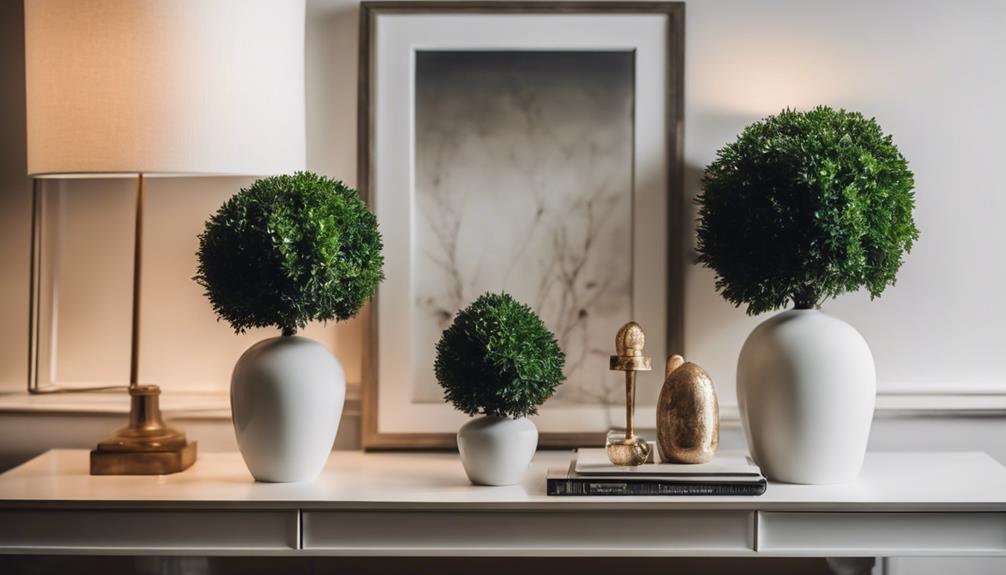
As top designers like Sarah Bartholomew and Martha Stewart have demonstrated, incorporating faux myrtle topiaries into your decor can add a touch of sophistication and elegance to any room. These versatile decor pieces can be styled in various ways to fit your unique space.
| Styling Tip | Location | Effect |
|---|---|---|
| Place on a mantel | Living Room | Adds a touch of greenery to a focal point |
| Use as a centerpiece | Dining Table | Creates a beautiful, low-maintenance tablescape |
| Add to an entryway | Foyer | Welcomes guests with a touch of elegance |
| Group with other decor | Shelves or Console | Creates a stunning vignette |
Frequently Asked Questions
How Big Do Myrtle Topiary Trees Get?
You're wondering how big myrtle topiary trees can get? Well, these trees typically reach heights of 18-24 inches, making them a great fit for indoor or outdoor display.
Their compact size is ideal for adding a touch of elegance to any space, and with proper care, they can thrive and maintain their beautiful shape.
Can Myrtle Topiary Stay Outside in Winter?
You're wondering if your myrtle topiary can stay outside in winter. Interestingly, did you know that myrtle topiaries can thrive outdoors year-round in USDA Hardiness Zones 8-11?
However, if you live in a colder climate, it's best to bring your topiary indoors during winter to protect it from frost. If that's not possible, provide some winter protection like mulching or covering to help it survive.
How to Get Myrtle Topiary to Bloom?
To get your myrtle topiary to bloom, you'll want to provide it with adequate sunlight exposure, as this is essential for flower production.
Regular fertilization during the growing season can also promote blooming.
Additionally, pruning practices like deadheading spent flowers can stimulate more blooms.
Does Myrtle Topiary Need Full Sun?
As you care for your myrtle topiary, you're wondering if it needs full sun.
The answer is yes, it prefers full sun to part shade for best growth and health.
In fact, adequate sunlight exposure is essential for maintaining its lush green foliage and overall vigor.
If you can't provide direct sunlight, placing it near a sunny window or in a well-lit area indoors can also work.
Conclusion
As you stand in your beautifully decorated space, surrounded by the elegant, lush greenery of your faux myrtle topiaries, it's hard not to feel a sense of serendipity.
Coincidence or not, it's as if the universe conspired to bring you and these stunning, low-maintenance wonders together.
With their effortless charm and versatility, it's little wonder they've become a staple in homes and gardens everywhere.
Vivienne – Your Content Companion Vivienne is your content companion, curating valuable tips, advice, and inspiration to guide you on your home decor journey. From insightful blog posts to informative product descriptions, she’s here to empower you with the knowledge you need to create your dream space.
Home Decor
Sustainable Home Decor: Eco-Friendly Design Guide
You can transform your living space into an eco-friendly haven, but do you know the best materials and practices to achieve this?
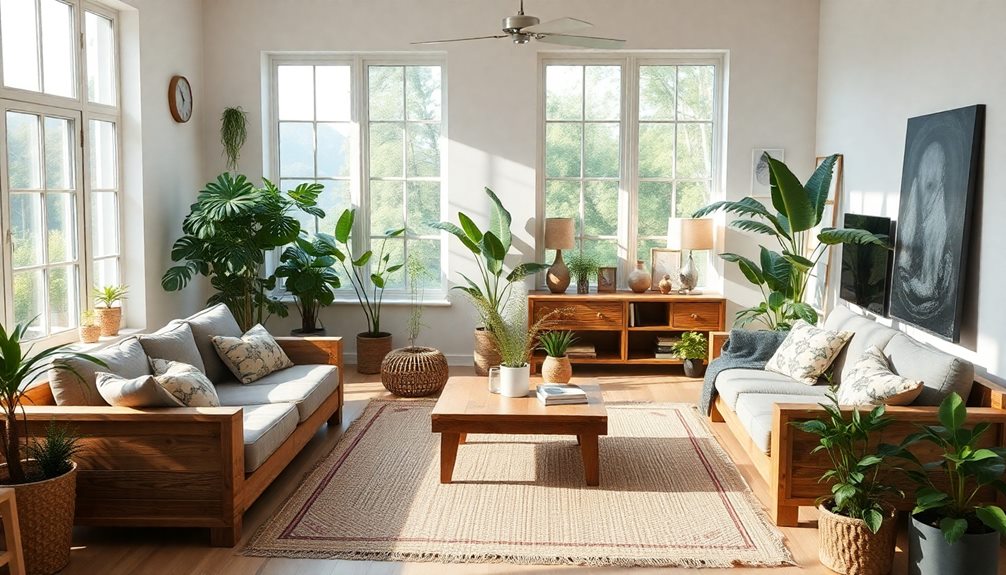
Sustainable home decor is essential for reducing your environmental impact while enhancing your space. Focus on using renewable materials, like reclaimed wood and bamboo, to minimize waste. Opt for low-VOC paints and non-toxic finishes to improve indoor air quality. Incorporate energy-efficient appliances and natural fibers for long-lasting beauty. When shopping, look for eco-friendly certifications such as FSC or GOTS to guarantee you're making ethical choices. Supporting local artisans can also boost your community while cutting down transport emissions. Keep exploring to discover more tips and tricks that can transform your home into a green haven.
Key Takeaways
- Prioritize renewable materials like bamboo and reclaimed wood to reduce environmental impact and enhance sustainability in your decor.
- Choose low-VOC or VOC-free paints to improve indoor air quality and promote healthier living spaces.
- Support local artisans and brands with eco-friendly certifications to encourage ethical practices and reduce transportation emissions.
- Incorporate indoor plants to filter air pollutants while adding beauty and vitality to your home.
- Invest in durable, high-quality furniture and accessories to achieve long-term savings and minimize waste.
Understanding Sustainable Design

Sustainable design is all about making choices that benefit both you and the planet. When you embrace sustainable design, you prioritize renewable materials, ensuring your home decor has a minimal environmental impact. This approach helps conserve resources and reduces your carbon footprint.
By integrating eco-friendly practices, like selecting non-toxic materials and low-VOC products, you not only enhance indoor air quality but also create a healthier living space for you and your family. Additionally, adopting the art of decluttering can further support sustainable living by minimizing excess and promoting conscious consumption.
Incorporating energy-efficient solutions, such as LED lighting and energy-efficient appliances, is essential to sustainable design. These choices not only lower your utility costs but also contribute to reduced resource consumption, aligning your home with ethical practices that respect the environment.
As you explore sustainable design, you'll notice a growing trend towards transparency in sourcing. More consumers like you're seeking products that reflect environmental values, driving manufacturers to adopt more responsible practices.
Benefits of Eco-Friendly Decor

Embracing eco-friendly decor not only beautifies your home but also considerably benefits the environment. By choosing sustainable materials, you can considerably reduce your environmental impact while enjoying a range of advantages.
Additionally, incorporating energy-efficient systems like heat pumps can further enhance your home's sustainability by considerably lowering energy costs and improving overall comfort through consistent indoor temperatures commercial heat pump benefits.
- Improved Indoor Air Quality: Using eco-friendly materials helps decrease exposure to harmful toxins and volatile organic compounds (VOCs), creating healthier living environments for you and your loved ones.
- Long-Term Savings: Investing in durable, sustainable materials often leads to long-term savings, as they typically last longer and require less maintenance than conventional options.
- Energy Efficiency: Opting for energy-efficient appliances and LED lighting can lower your utility bills while reducing energy consumption, adding to your overall sustainability efforts.
- Support for Local Economies: By selecting eco-friendly decor, you're not just making a smart choice for your home; you're also supporting local economies and ethical labor practices, fostering a positive impact on communities.
Ultimately, making eco-friendly decor choices helps minimize environmental impact and contributes to the fight against climate change, all while transforming your space into a beautiful sanctuary.
Tips for Ethical Decor Choices

When you're looking to refresh your home decor, making ethical choices can greatly impact both your space and the environment. Start by prioritizing sustainable materials with eco-friendly certifications, like FSC for wood and GOTS for textiles. This guarantees that the products you choose are sourced responsibly.
Incorporating natural materials, such as reclaimed wood and metal, can enhance the rustic charm often found in farmhouse decor while also being eco-conscious. Opt for furniture and accessories made from reclaimed or recycled materials, which help reduce waste and lower your carbon footprint.
Additionally, select low-VOC or VOC-free paints and finishes to enhance your home's indoor air quality. Traditional paints can release harmful chemicals that negatively affect your health. Incorporating indoor plants not only adds beauty to your decor but also filters air pollutants, further improving overall air quality.
Support local artisans and businesses that practice sustainability. This helps foster community economies and reduces transportation emissions related to decor products.
Sustainable Material Options

When choosing materials for your home decor, consider sustainable options like bamboo, cork, and reclaimed wood.
These eco-friendly choices not only reduce environmental impact but also enhance your living space's aesthetic and air quality.
Types of Sustainable Materials
In your quest for eco-friendly home decor, understanding the various types of sustainable materials is essential. Choosing the right materials not only enhances your space but also helps reduce your environmental impact.
Here are four sustainable material options to evaluate:
- Bamboo: This rapidly renewable resource grows up to 35 inches per day, making it perfect for furniture and flooring. Its strength and versatility are unmatched.
- Reclaimed Wood: By repurposing old wood from buildings and furniture, reclaimed wood reduces the demand for new timber, minimizes waste, and preserves forests.
- Cork: Harvested from the bark of cork oak trees without harming them, cork is a renewable material with antimicrobial properties, making it ideal for flooring and wall coverings.
- Recycled Metals: Using materials like aluminum and steel conserves natural resources, as recycling metal uses 95% less energy than creating new metal from ore.
Additionally, evaluate natural fibers such as organic cotton, jute, and hemp, which are biodegradable and promote sustainable agriculture.
Benefits of Eco-Friendly Options
Choosing eco-friendly options for your home decor not only benefits the environment but also enhances your living space. By opting for sustainable materials like bamboo and reclaimed wood, you support renewable resources that help reduce deforestation. This eco-friendly choice adds warmth and character to your decor while promoting environmental sustainability.
Using organic textiles, such as cotton and linen, minimizes your exposure to harmful chemicals, improving indoor air quality. You'll notice a difference in how fresh your home feels.
Incorporating materials like cork, which is harvested sustainably, not only provides aesthetic appeal but also offers natural antimicrobial properties.
Consider decor items made from recycled metals; these conserve natural resources and cut down on the energy consumption required for new materials.
Plus, choosing low-VOC paints can greatly enhance your indoor air quality by reducing harmful emissions.
Eco-Friendly Paint Selection

When you're choosing paint for your home, consider options that promote healthier indoor air quality by opting for low-VOC or VOC-free products.
You'll also want to explore non-toxic and vegan paint alternatives that align with your ethical values.
Healthier Indoor Air Quality
Improving your indoor air quality starts with selecting the right paint for your home. Conventional paints often contain volatile organic compounds (VOCs) that can lead to health issues like headaches and respiratory problems.
By choosing eco-friendly paint options, you can greatly enhance your living environment.
Consider these four tips for healthier indoor air quality:
- Opt for Low-VOC or VOC-Free Paints: These paints will minimize harmful emissions during and after application.
- Check for Certifications: Look for labels like Greenguard or Green Seal, which indicate low emissions and safer indoor air quality.
- Choose Biodegradable Options: Eco-friendly alternatives like milk paint and chalk paint not only reduce harmful chemicals but also are made from sustainable materials.
- Read Ingredient Labels: Verify your paint doesn't contain non-vegan options like casein or shellac, which may not align with your ethical choices.
Non-Toxic Paint Options
As you explore eco-friendly paint options, you'll discover a range of non-toxic alternatives that not only enhance your home's aesthetic but also safeguard your health.
Many conventional paints contain volatile organic compounds (VOCs), which can harm indoor air quality and lead to health issues like headaches and nausea. By opting for low-VOC or VOC-free paints, you can greatly improve the air quality in your space.
Non-toxic paint options like milk paint, chalk paint, and linseed oil paint are excellent eco-friendly alternatives, often biodegradable and made from natural ingredients.
Look for brands that prioritize sustainability and transparency in their formulations, certified by organizations like Green Seal or the Environmental Working Group (EWG).
If you're following a vegan lifestyle, be mindful that some traditional paints may contain animal byproducts such as casein and shellac.
Choose brands explicitly labeled as vegan to align with your ethical standards.
Additionally, many non-toxic paints come with added benefits, like antimicrobial properties found in ceramic paints, which can enhance the overall hygiene of your living environment.
Choose wisely, and enjoy a healthier home!
Vegan Paint Alternatives
Many eco-conscious homeowners are now seeking vegan paint alternatives that align with their values. These options not only support animal welfare but also enhance indoor air quality, thanks to their low or zero volatile organic compounds (VOCs).
Here are four compelling vegan paint alternatives to evaluate:
- Milk Paint: Made from natural ingredients like milk protein and lime, this biodegradable choice adheres well to various surfaces.
- ECOS Paints: Known for their commitment to eco-friendly products, they offer paints with zero VOCs, promoting a healthier home environment.
- BioShield: This brand provides sustainable paint options made from natural ingredients and recycled materials, catering to environmentally conscious consumers.
- Plant-Based Paints: These paints are crafted with non-toxic, plant-derived components, ensuring a safe and sustainable choice for your home.
Choosing vegan paint alternatives means you're making a conscious decision to use sustainable materials that are biodegradable and packaged responsibly.
Sustainable Furniture and Accessories

Sustainable furniture and accessories not only enhance your home's aesthetic but also support environmental responsibility. By opting for sustainable furniture made from FSC-certified wood, bamboo, or reclaimed materials, you help reduce deforestation and promote responsible sourcing practices. This choice not only benefits the environment but also improves your indoor air quality, especially when you select pieces finished with eco-friendly coatings that are low in VOCs.
You can further express your creativity and individuality by upcycling and repurposing old furniture. This approach minimizes waste and adds a unique touch to your decor. Accessories made from recycled materials, like glass or metal, not only reduce your environmental impact but also provide a modern flair to your spaces.
Investing in durable, high-quality sustainable furniture and accessories means you'll enjoy long-term cost savings. These pieces typically outlast their conventional counterparts, requiring less frequent replacement.
Shopping for Eco-Friendly Decor

When you're shopping for eco-friendly decor, prioritizing certifications like FSC or GOTS can make a significant difference in your choices.
These labels guarantee that the materials are sustainably sourced and produced, greatly reducing your environmental impact.
Here are four key tips to keep in mind:
- Look for Sustainable Materials: Choose items made from bamboo, organic cotton, or recycled materials to diminish harmful effects on the planet.
- Research Certifications: Verify brands' commitment to eco-friendly practices by checking for certifications from organizations like the Sustainable Furnishings Council (SFC).
- Support Circular Business Models: Opt for companies that prioritize recycling and offer take-back programs to reduce waste.
- Consider Longevity and Durability: Invest in high-quality, eco-friendly decor that lasts, as this leads to long-term savings and less waste over time.
Frequently Asked Questions
How to Create a Sustainable and Eco-Friendly Home Design?
To create a sustainable and eco-friendly home design, prioritize low-impact materials, choose energy-efficient appliances, use non-toxic paints, incorporate indoor plants, and support local artisans. These steps enhance your space while reducing environmental harm.
What Is the Best Design for a Sustainable House?
Designing a sustainable house is like crafting a living organism; it breathes energy efficiency. Prioritize passive solar techniques, renewable materials, and smart technology. You'll create a harmonious space that nurtures both you and the environment.
How Do You Make Eco-Friendly Decorations?
You can make eco-friendly decorations by using reclaimed materials, incorporating indoor plants, opting for non-toxic paints, repurposing old items, and choosing textiles made from organic or recycled fabrics to minimize your environmental impact.
How to Incorporate Sustainability in Interior Design?
To incorporate sustainability in interior design, choose eco-friendly materials, use energy-efficient appliances, opt for low-VOC paints, add indoor plants, and research brands for sustainable certifications. You'll create a healthier, more environmentally conscious living space.
Conclusion
Embracing sustainable home decor not only enhances your space but also nurtures the planet. By making mindful choices, you're weaving a tapestry of eco-friendliness into your life, one piece at a time. Remember, every small decision counts—like drops of water filling a well. So, as you decorate, let your home reflect your values and inspire others to join the green movement. Together, you can create a beautiful world that's both stylish and sustainable.
Xavier – Your Operations Partner Xavier is your operations partner, working tirelessly behind the scenes to ensure that everything runs smoothly so you can enjoy a seamless experience with Perfect Fit Living. From managing inventory to coordinating logistics, he’s committed to making your experience with us hassle-free.
Home Decor
Maximalist Decor: How to Do It Right
Curate your space with bold colors and textures to achieve stunning maximalist decor; discover essential tips for perfecting this vibrant aesthetic.
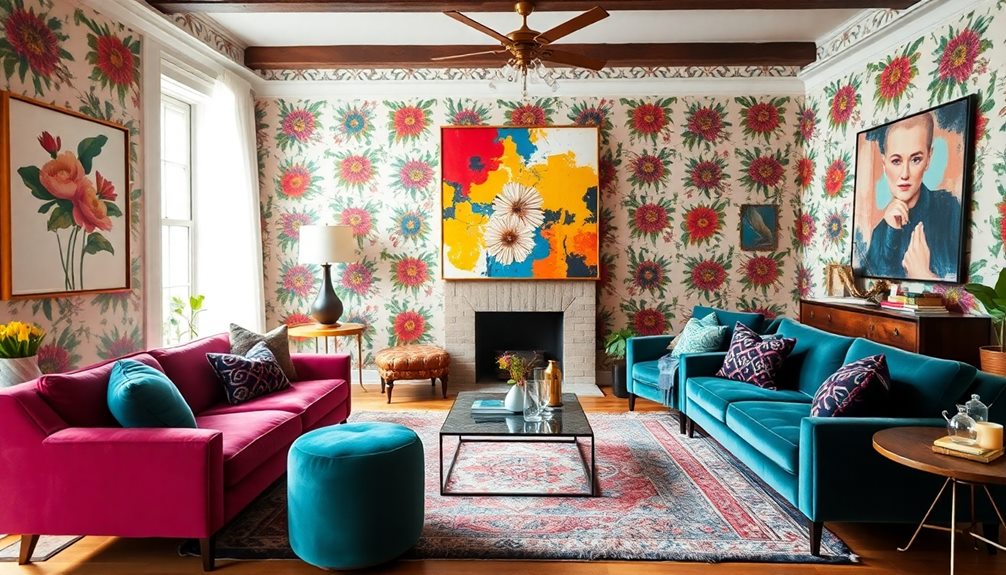
Maximalist decor is all about embracing bold expression and eclectic styles to create a unique space. Start with a cohesive color palette of 3-5 main colors to unify your design. Layer different textures, including fabrics like velvet and silk, to add depth and richness. Mix patterns—big with small—while maintaining color harmony to avoid chaos. Group collections of items in odd numbers for visual interest, and don't shy away from using negative space to balance boldness. With careful planning, your space will feel vibrant and personalized. There's more to explore for achieving this stunning aesthetic.
Key Takeaways
- Establish a cohesive color palette of 3-5 main colors to unify diverse decor elements while allowing for bold contrasts.
- Layer various textures, such as velvet and silk, to create richness and visual interest in your space.
- Mix patterns thoughtfully, balancing bold designs with subtler ones to enhance visual complexity without overwhelming the room.
- Curate personal collections by grouping similar items in clusters of three or five for impactful and dynamic displays.
- Utilize negative space effectively to prevent clutter and allow bold decor choices to stand out beautifully.
Defining Maximalism in Decor
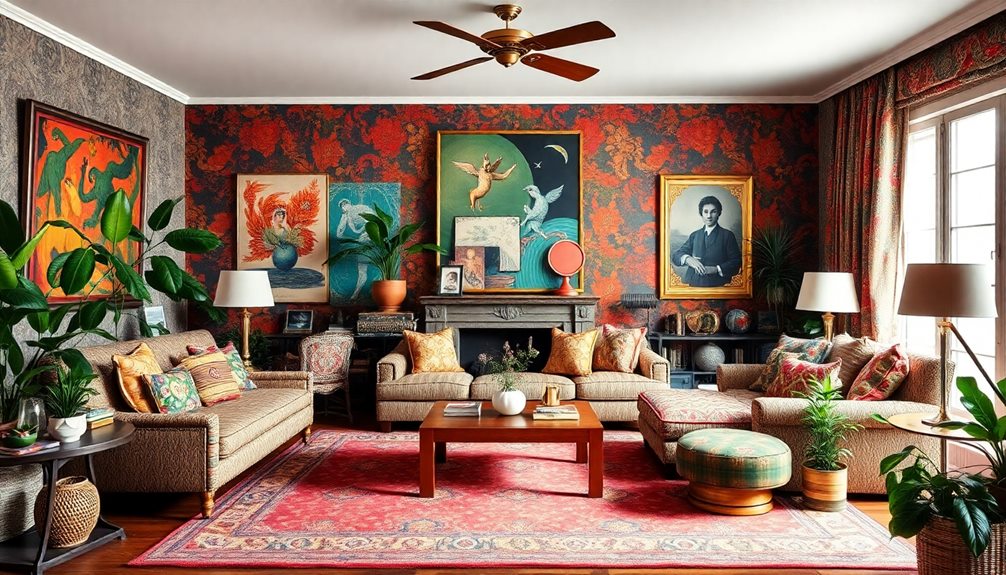
Maximalism in decor isn't just about filling a space; it's a vibrant celebration of personal expression and individuality. This approach to interior design thrives on the idea that "more is more," allowing you to showcase your unique tastes through an eclectic mix of colors, patterns, and decorative items.
In a maximalist living room, you might layer bold textiles, incorporate a variety of textures, and display cherished collections—all elements that reflect your personal style.
Incorporating elements from different cultural styles, such as traditional Indonesian style home decor, can enhance your maximalist aesthetic by adding depth and richness.
A cohesive color palette is vital in maximalist design. It unifies diverse elements, creating harmony amid the vibrant chaos. You can choose a bold, rich palette that resonates with your personality, ensuring that even the busiest patterns feel intentional.
Imagine a space filled with daring prints, from floral to geometric, each serving as a backdrop for your artistic expression.
Key Elements of Maximalist Design

When you're embracing maximalist design, start by focusing on color cohesion strategies that unify your space while allowing for bold contrasts.
Layering textures effectively is equally important; mixing materials like velvet, silk, and leather can create a rich, inviting atmosphere.
Together, these elements make your decor feel dynamic and personalized.
Color Cohesion Strategies
Establishing a cohesive color palette is essential for achieving a harmonious maximalist design. Start by selecting 3-5 main colors that reflect the desired mood of your space. Confirm that each piece of furniture, artwork, and accessory complements this cohesive scheme.
To create a sense of unity, repeat these colors across different rooms, making your home feel interconnected and inviting.
Don't shy away from bold hues like cobalt blue or blush pink; these can function as neutral tones, enhancing versatility while keeping your aesthetic intact. Incorporate varying shades of the same color in different patterns and textures to add depth, confirming you remain within your overall color palette.
Balancing vibrant colors with neutral bases—think white or beige walls and large furnishings—provides visual breaks and prevents the space from feeling overwhelming. This strategy allows the bold colors to pop without clashing.
Layering Textures Effectively
Layering textures effectively transforms a space into a rich tapestry of visual and tactile experiences. By mixing materials like velvet, silk, leather, and cotton, you create depth and visual interest.
Start by incorporating various textiles through rugs, cushions, and throws to enhance comfort and warmth, providing a rich tactile experience.
It's essential to focus on balancing textures. Pair heavier materials, like thick wool or plush upholstery, with lighter options, such as linen or sheer fabrics. This balance prevents overwhelming the design while maintaining visual harmony.
To create a striking focal point, strategically layer textures. For example, combine a bold patterned sofa with a contrasting textured throw; this draws attention and enhances the overall aesthetic.
Don't shy away from experimenting with the scale of textures, either. Make sure that large, dominant patterns are balanced by smaller, subtler textures to avoid visual chaos and keep the composition engaging.
Incorporating these layering techniques will elevate your maximalist decor, making your space feel both inviting and dynamic. Embrace the beauty of textures, and watch your design come to life!
Practical Tips for Maximalism
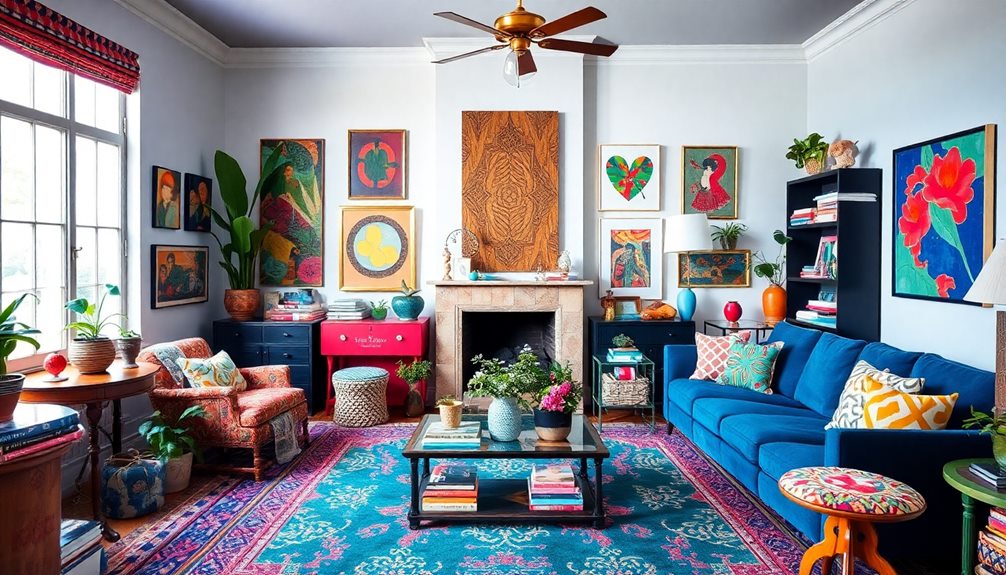
To create a stunning maximalist space, start with a neutral foundation that sets the stage for bold patterns and vibrant colors. Using a tone-on-tone palette or solid colors allows you to mix prints without overwhelming your interior.
Consider incorporating elements that enhance creating seamless indoor-outdoor flow to bring a harmonious connection between spaces. Choose a cohesive color palette that harmonizes across your furnishings, fabrics, and artwork to maintain unity throughout the room.
When it comes to decor, group similar items in clusters of three or five. This tip enhances visual strength and creates impactful focal points that draw the eye.
Don't shy away from incorporating a variety of textures and materials, like velvet, leather, and natural fibers, to add depth and richness to your maximalist design.
Embrace negative space by allowing select objects to breathe. This prevents visual clutter and enhances the overall aesthetic of your space.
Balancing Color and Texture
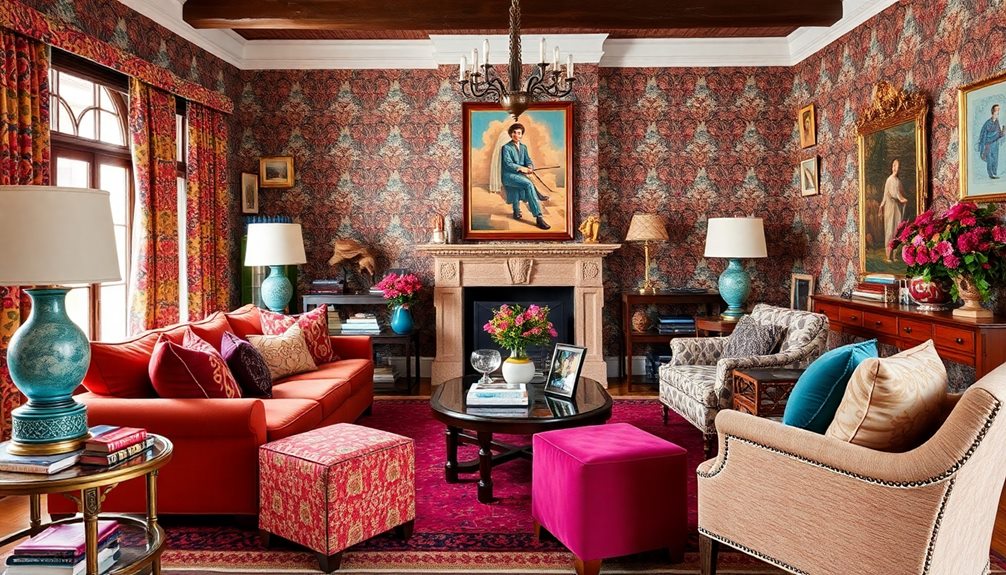
To create a truly stunning maximalist space, you'll want to harmonize bold colors while layering textures intentionally.
Mixing patterns effectively can elevate your design, adding complexity without chaos.
Harmonize Bold Colors
Maximalist decor thrives on the vibrant interplay of colors and textures, creating spaces that are both stimulating and inviting. To harmonize bold colors, you should start with a cohesive color palette that mixes bold hues with softer shades. This approach not only embraces the maximalist aesthetic but also helps maintain visual harmony.
Don't forget to incorporate accent colors; they can link various elements in your room, ensuring that your vibrant pieces coexist without clashing. For instance, cobalt blue and blush pink can serve as neutral tones amidst the bold colors.
Repeating certain hues across decor items—think artwork, cushions, and furniture—fosters a sense of unity throughout the space. This repetition is key in creating that fluid connection you're after.
Additionally, effectively utilizing negative space will allow your bold colors to stand out, preventing the room from feeling overwhelming. Instead of clutter, aim for a balanced look that celebrates the "more is more" philosophy of maximalism.
Layer Textures Intentionally
In a well-designed maximalist space, layering textures intentionally makes all the difference. It adds depth and richness, creating a cozy atmosphere that invites you in.
By thoughtfully combining materials, you can enhance visual intrigue while ensuring a cohesive mix that unifies diverse elements. For instance, incorporating elements from Boho Chic Bedroom Decor can introduce eclectic patterns and soft fabrics that elevate comfort.
Here's how to layer textures effectively:
- Combine Soft and Hard: Pair soft textiles like velvet and silk with harder surfaces such as glass or metal to create dynamic contrast.
- Incorporate Varied Materials: Use a mix of leather, wood, and metals to enrich your decor and add interest.
- Repeat Textures for Cohesion: Introduce certain textures throughout the space to maintain a sense of flow and harmony.
- Strategic Patterns: When using patterns, balance bold prints with subtler designs to avoid visual chaos, keeping things engaging yet manageable.
Mix Patterns Effectively
Mixing patterns effectively can transform a space from ordinary to extraordinary, adding vibrancy and character. To achieve this in your maximalist style, start by considering the scale of the patterns you choose.
Use smaller patterns in confined areas and larger ones in expansive spaces to maintain visual balance. A cohesive color palette is essential; it unites all patterns, preventing chaos while enhancing harmony.
Don't overlook texture—combine materials like velvet, linen, and silk to add depth and interest. Ascertain these textures complement each other visually.
Group your favorite things by theme or color; for instance, floral prints can be paired with geometric designs if they share a common color scheme.
Curating Personal Collections
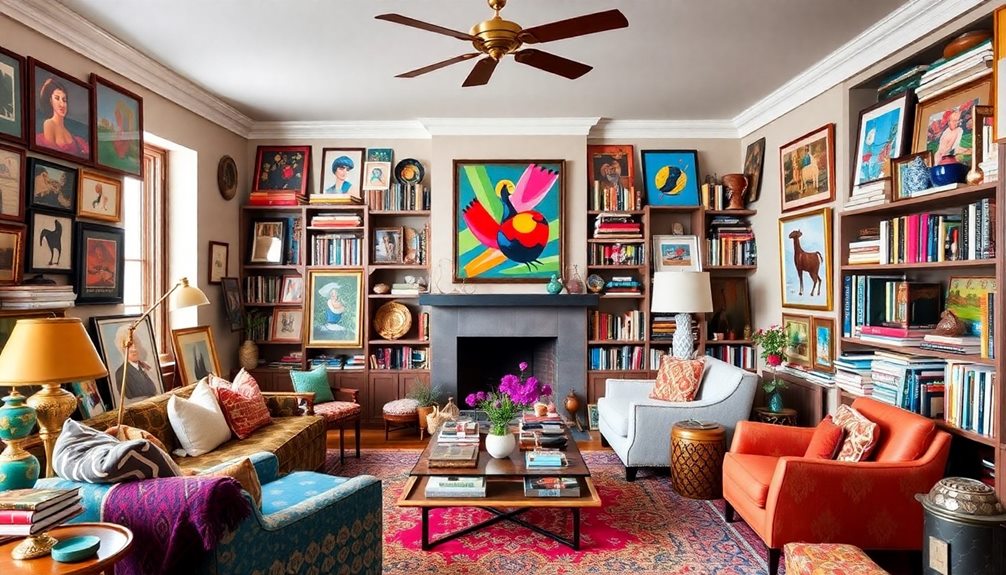
Curating personal collections in your home is an opportunity to tell your unique story through decor. Maximalism design invites you to showcase items you love, celebrating their significance while creating a cohesive aesthetic.
To effectively curate your collections, consider these ideas:
- Group Similar Items: Arrange vases, books, or art pieces together to enhance visual strength. Aim for arrangements of three or five for maximum impact.
- Embrace Varied Heights: Use staggered arrangements and varied heights in your displays. This adds dynamic composition and avoids boring uniform lines.
- Incorporate Meaningful Displays: Include curated pieces like travel souvenirs or inherited heirlooms, emphasizing the stories behind each item. This enhances storytelling through decor.
- Gradual Addition: Focus on curating collections over time. Add meaningful items gradually to maintain an eclectic yet cohesive look that reflects your personality.
Maximizing Space and Light
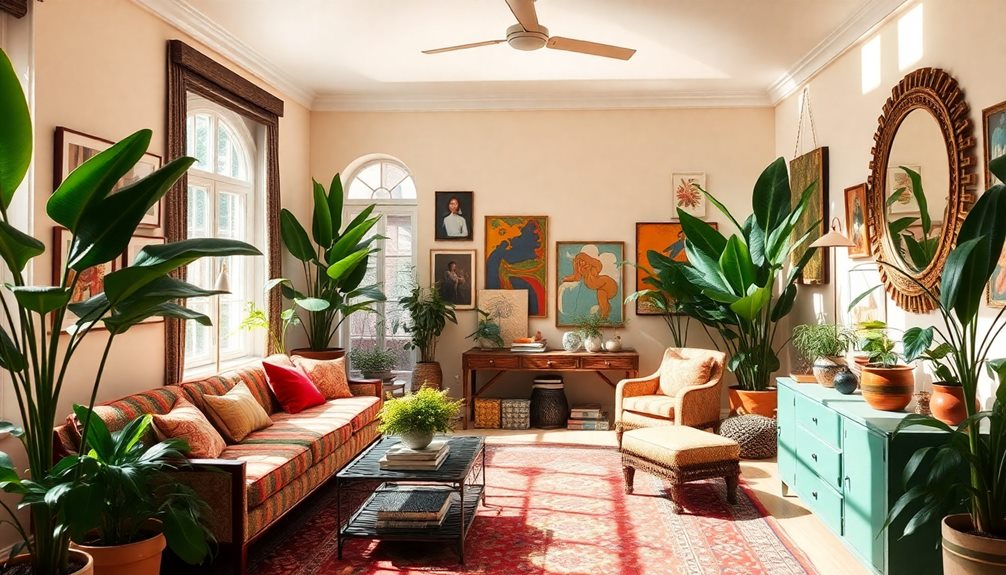
Maximalist decor can sometimes feel overwhelming, but with the right strategies, you can create a space that feels open and inviting.
Start by utilizing vertical surfaces; installing shelves and hanging art keeps your floor space open and visually accessible. This allows you to showcase your collections without cluttering the area.
Incorporate mirrors strategically to enhance the overall brightness of your maximalist interior. They create the illusion of more space while reflecting light, making your room feel airy and expansive.
Choosing multifunctional furniture is another smart move. Opt for ottomans with storage or coffee tables that double as workspaces, helping you maintain functionality without overcrowding.
Light-colored walls or large windows invite natural light, balancing the bold colors and patterns typical of maximalist design. This not only brightens the room but also makes it feel larger.
Frequently Asked Questions
How to Start Maximalist Decor?
To start maximalist decor, you'll want to establish a neutral base first. Then, choose a cohesive color palette, embrace bold statement pieces, and layer your decor gradually while balancing negative space for visual interest.
How to Do Maximalism Right?
Mastering maximalism's vibrant dance means weaving bold colors, cherished treasures, and harmonious patterns. You'll breathe life into your space by layering textures, balancing elements, and embracing negative space, creating an inviting, eclectic masterpiece that tells your story.
What Are the Principles of Maximalist?
When exploring maximalism, focus on bold colors and patterns, layer various textures, curate collections, and balance visual weight. These principles help you create engaging, personalized spaces that reflect your unique style and story.
How to Be a Maximalist Without Clutter?
To be a maximalist without clutter, start with a neutral base, curate meaningful items, and strategically place decor. Embrace negative space and use stylish storage solutions to keep essentials accessible yet visually harmonious.
Conclusion
Embracing maximalist decor is like painting your life with vibrant strokes, each color telling a story. By layering textures and curating cherished collections, you create a sanctuary that reflects your soul. Don't shy away from bold choices; instead, let them dance together, igniting joy in every corner. Remember, your space should feel like an embrace—a mosaic of memories and dreams. So go ahead, release your creativity, and transform your home into a vivid tapestry of who you truly are.
Xavier – Your Operations Partner Xavier is your operations partner, working tirelessly behind the scenes to ensure that everything runs smoothly so you can enjoy a seamless experience with Perfect Fit Living. From managing inventory to coordinating logistics, he’s committed to making your experience with us hassle-free.
Home Decor
Indoor Plant Styling: From Floor to Ceiling
Transform your space with indoor plant styling techniques that enhance beauty and air quality—discover the secrets to creating your lush oasis.
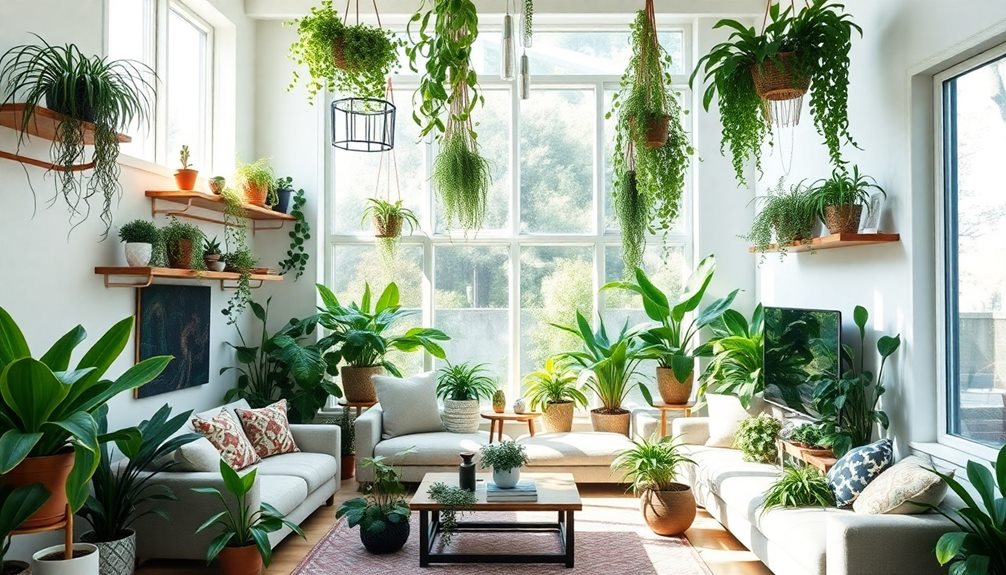
Indoor plant styling can elevate your space, enhancing both beauty and air quality from floor to ceiling. Start by evaluating your light conditions and choosing the right plants that fit your room. Use creative display ideas, like wall-mounted planters and hanging plants, to maximize your vertical space. To personalize your style, mix unique pots and group plants in odd numbers for balance. Regular care, such as checking soil moisture and dusting leaves, will keep your plants thriving. Ready to transform your home into a lush oasis? There's plenty more to discover that can elevate your plant game even further!
Key Takeaways
- Utilize wall-mounted planters and shelves to maximize vertical space and showcase plants without cluttering the floor.
- Incorporate hanging plants to draw the eye upward, enhancing spatial perception and adding visual interest.
- Select decorative pots that align with your room's decor style for a cohesive aesthetic throughout the space.
- Group plants in odd numbers for balance and visual appeal, creating harmonious arrangements across different heights.
- Mix various plant species with unique shapes and textures to enhance dynamism and interest from floor to ceiling.
Benefits of Houseplants

When you bring houseplants into your home, you're not just adding a touch of greenery; you're also reaping a multitude of benefits. One of the most significant advantages of houseplants is their ability to improve air quality. They filter out toxins like formaldehyde and benzene, enhancing your overall indoor health.
Additionally, certain houseplants are known to help reduce stress levels, making them a great addition to any home environment.
Furthermore, indoor plants can dramatically reduce stress levels. Studies show that having plants around can lower blood pressure and heart rate, leading to a more relaxed atmosphere.
With increased humidity from your plants, you'll also notice improvements in skin health and respiratory function, especially in dry environments.
Moreover, if you work from home, incorporating greenery in your workspace can boost productivity and concentration by as much as 15%. This simple addition to your home decor promotes a sense of well-being and connection to nature, which is linked to better mental health outcomes.
In short, the benefits of houseplants extend far beyond aesthetics. By choosing to include indoor plants in your living space, you're making a positive impact on your health and overall happiness.
Choosing the Right Plants

When you're choosing the right indoor plants, start by evaluating the light conditions in your space to find plants that thrive in those settings.
Next, think about the size of your area and how larger plants can make a statement versus how smaller ones can fit on shelves.
If you have pets, guarantee you pick non-toxic options to keep everyone safe while enhancing your home.
Assessing Light Conditions
Evaluating light conditions is often the most important step before choosing indoor plants. Understanding how light levels vary in your space helps guarantee your plants thrive.
Here's a quick guide to evaluating light conditions:
- Identify Direct vs. Indirect Light: Direct sunlight means at least 6 hours of bright light daily, while indirect light occurs in filtered spaces.
- Monitor Seasonal Changes: Light availability changes with the seasons. Keep an eye on how your plants respond throughout the year.
- Use a Light Meter: To get precise readings, consider using a light meter. This tool helps you measure the intensity of light in different areas.
- Observe Window Placement: Note how light enters through windows. South-facing windows receive the most light, while north-facing ones get less.
Plant Size Considerations
Selecting the right plants for your indoor space involves considering both the size of your room and the scale of your furniture. When you think about plant size considerations, larger plants like fiddle leaf figs can make a statement in spacious areas, while smaller plants such as succulents fit better in compact spaces.
Larger plants generally need more water due to their increased leaf surface area, making proper watering techniques vital for keeping them healthy. Aim for at least 6-8 inches of clearance around larger plants to guarantee airflow and prevent mold or disease.
To create visually appealing arrangements, group your plants in odd numbers, like three or five. This approach draws the eye and maintains balance in your decor.
Position tall plants in corners or next to large furniture pieces to anchor the space and avoid clutter. Smaller plants can easily find their home on shelves or tabletops, maximizing your use of space and time.
Pet-Friendly Options
Creating a vibrant indoor space while ensuring your pets are safe requires careful plant selection. You want to choose pet-friendly plants that enhance your home without putting your furry friends at risk.
Selecting plants can be similar to choosing eco-friendly toys for children, as both involve prioritizing safety and well-being. Here are four great options to take into account:
- Spider Plant: Known for its air-purifying qualities, this plant is non-toxic to both cats and dogs.
- Boston Fern: This lush, green option adds a touch of elegance and is safe for your pets.
- Parlor Palm: An excellent choice for low-light areas, this palm not only looks good but is also non-toxic.
- Bamboo Palm: With its tropical vibe, this palm improves air quality and is safe for your pets.
The American Society for the Prevention of Cruelty to Animals (ASPCA) offers a detailed list to help you identify toxic and non-toxic plants.
Remember, even pet-friendly plants can cause mild gastrointestinal upset if ingested in large quantities, so keep an eye on your pets' behavior around them.
Creative Display Ideas
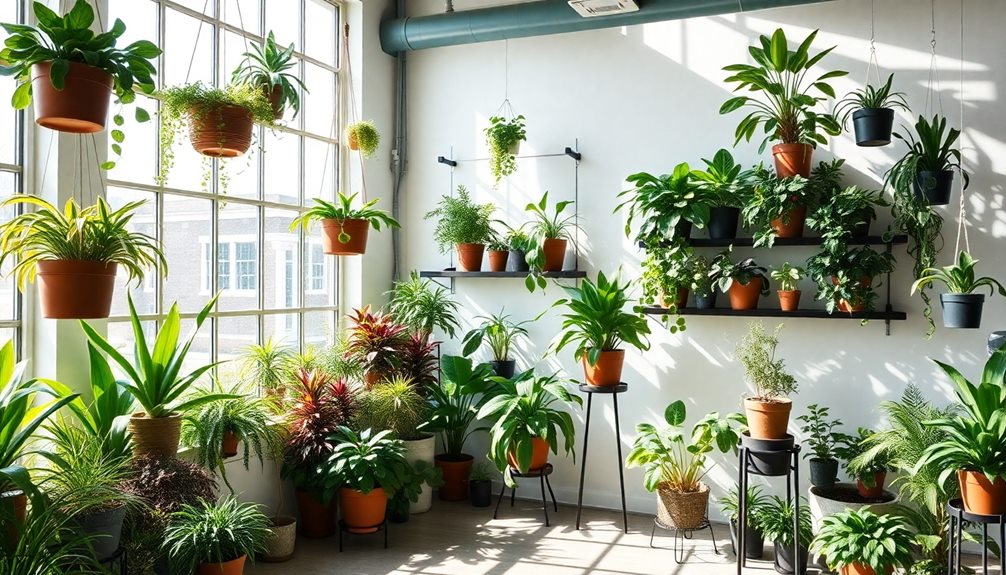
When it comes to displaying your plants, think vertically to maximize your space and create an eye-catching wall of greenery.
Unique containers, like repurposed jars or quirky pottery, can add personality and spark conversation.
Vertical Space Utilization
Maximizing vertical space is essential for transforming any indoor area into a vibrant sanctuary filled with greenery. You can creatively display your humble houseplants while ensuring your space feels open and inviting.
Here are some effective ideas:
- Wall-Mounted Planters: Utilize wall-mounted planters to showcase a variety of plants without sacrificing floor space. They create a stunning visual effect and can be arranged in patterns for added flair.
- Hanging Plants: Use plant hangers to suspend plants from ceilings or high shelves. This technique draws the eye upward, enhancing the sense of space and adding depth to your decor.
- Tiered Plant Stands: Incorporate tiered plant stands or ladders to arrange your plants at different heights. This not only maximizes light exposure but also makes it easier to care for your plants.
- Vertical Gardens: Consider creating a vertical garden or living wall. This bold design statement can transform a small area into a lush oasis while improving air quality.
Unique Container Ideas
Transforming your indoor space can be as simple as choosing the right containers for your plants. Unique container ideas can elevate your decor while showcasing your greenery. One way to achieve this is through upcycling everyday items like mason jars, tin cans, and wooden crates. These personalized plant containers not only add character but are also environmentally friendly.
Consider using decorative baskets for your potted plants. They add texture and make it easy to rearrange your space as needed. For a modern twist, incorporate terrariums made from glass containers. These eye-catching displays can create miniature ecosystems that draw attention.
Hanging planters crafted from macramé or repurposed materials can bring vertical interest to your home, especially in limited spaces. This allows your plants to thrive while creating a dynamic aesthetic.
Finally, think about integrating furniture with built-in planters, such as coffee tables or shelving units. This combination of functionality and style helps you utilize space effectively while showcasing your plants beautifully.
With these unique container ideas, you can transform your indoor environment into a lush oasis.
Vertical Space Utilization
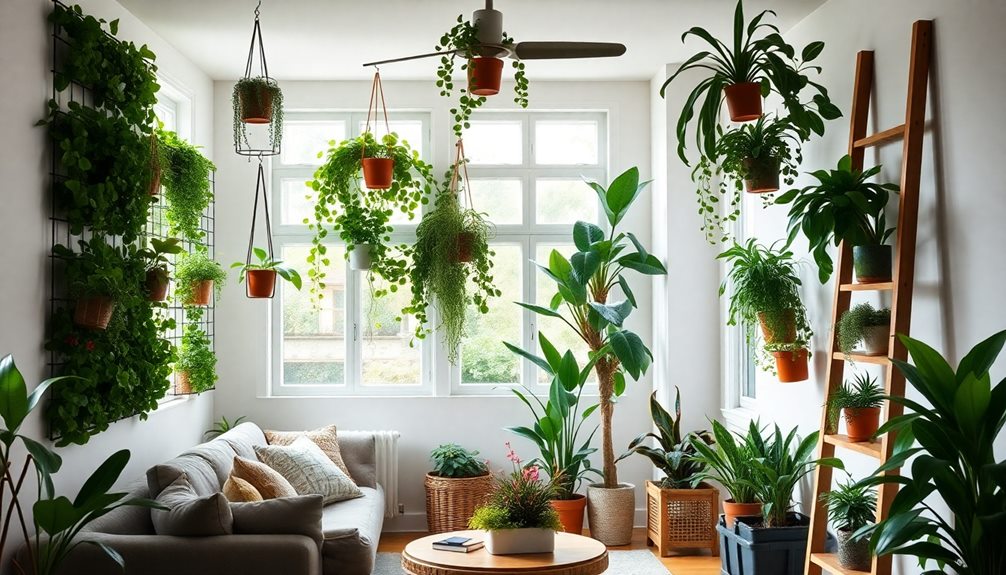
In recent years, utilizing vertical space in your home has become an essential strategy for adding greenery without cluttering your floors.
By incorporating plants in innovative ways, you can enhance the aesthetic of small rooms while also enjoying health benefits. Here are some effective methods to maximize vertical space:
- Wall-Mounted Planters: Install these to create stunning green accents on your walls. They're perfect for small spaces and can add a pop of color.
- Hanging Plants: Suspend plants from ceilings or walls to draw the eye upward. This not only creates dynamic visual interest but also makes your space feel larger and more open.
- Vertical Gardens: Consider a living wall to improve air quality and humidity while serving as a striking decor piece.
- Trellises for Climbing Plants: Use trellises or plant stands to support climbing plants, transforming bare walls into lush displays.
Indoor Plant Decor Trends
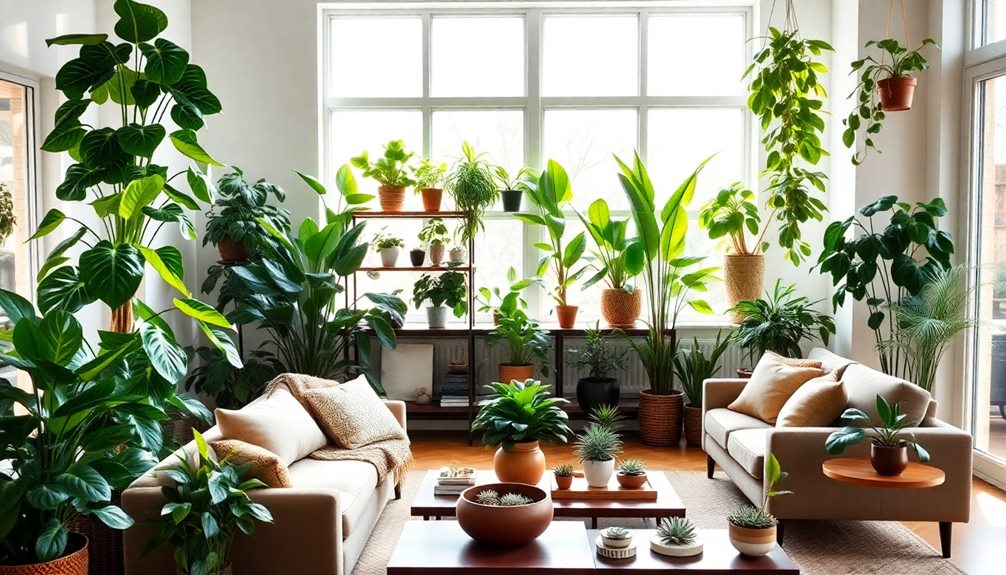
As you elevate your indoor plant game with vertical space utilization, it's also important to stay updated on the latest decor trends shaping how we incorporate greenery into our homes. A significant 70% of homeowners agree that indoor plant decor enhances their living spaces and overall ambiance.
Biophilic design principles are gaining popularity, emphasizing our connection to nature and inspiring urban jungle aesthetics that bring the outdoors inside.
DIY terrariums and vertical gardens are now trendy, allowing you to showcase your unique style while maximizing your space. These creative options not only look stunning but also make a statement about your personality and passion for plants.
Moreover, there's a surge in demand for rare and exotic houseplants, with online searches for unique species rising by 50% over the past year. This reflects a growing desire for distinctive indoor greenery that sets your space apart.
Finally, sustainable decor practices are on the rise, as 45% of consumers prefer upcycled planters and organic plant care products, aligning with the movement toward environmentally conscious living.
Embrace these trends to create a lush, inviting atmosphere in your home.
Care and Maintenance Tips

Caring for your indoor plants is essential to guaranteeing they thrive and enhance your living space. With the right care and maintenance, you can create an environment where your plants flourish. Here are some tips to keep in mind:
- Watering: Establish a consistent watering schedule by checking the top inch of soil for dryness. Most houseplants prefer to dry out slightly between waterings to prevent root rot.
- Soil: Use a well-draining potting mix tailored to your plant's needs. This guarantees adequate drainage and supports healthy root development.
- Dusting: Regularly dust the leaves with a damp cloth. This enhances photosynthesis and maintains plant health by preventing dust from hindering light absorption.
- Pruning: Prune dead or yellowing leaves as needed. This not only encourages new growth but also helps maintain a tidy appearance and prevents potential pest infestations.
Additionally, monitor light conditions and adjust plant placement accordingly.
Rotating your plants periodically will guarantee they receive even light exposure, promoting balanced growth.
With these simple steps, your indoor plants will thrive and bring life to your space.
Personalizing Your Plant Style
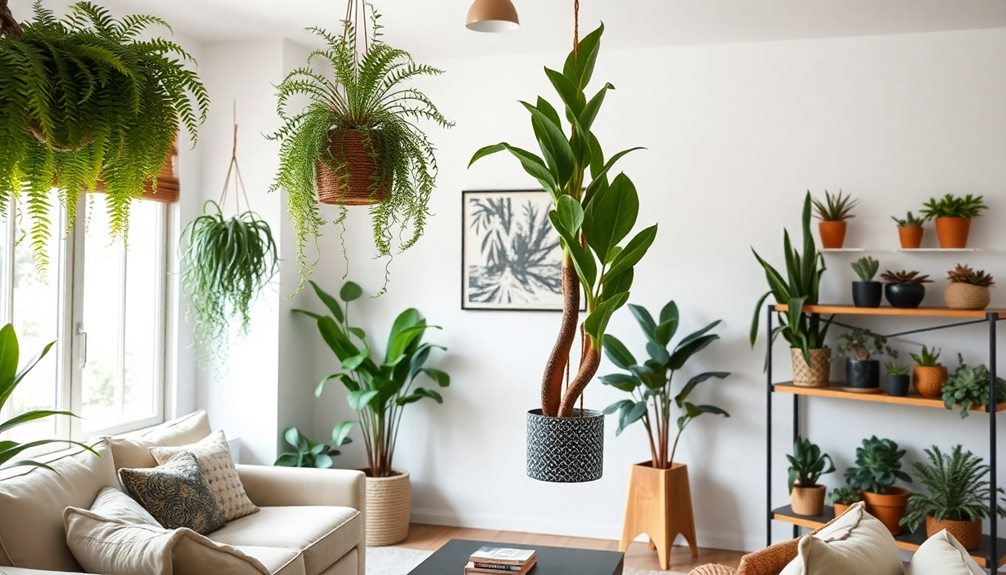
Transforming your indoor space with plants goes beyond simply choosing greenery; it's about expressing your personal style. Start by selecting species that resonate with you. For instance, spiky succulents offer a modern aesthetic, while lush ferns can create a tropical vibe. Mixing various leaf shapes and textures enhances visual interest, making your space more dynamic.
To elevate your plant displays, consider decorative pots that align with your room's color scheme. Modern geometric designs can complement contemporary decor, while rustic terra-cotta pots add a touch of warmth. Grouping plants in odd numbers—like three or five—creates a balanced arrangement that draws the eye.
Incorporating personal touches, such as handmade macramé hangers or repurposed vintage containers, allows for unique expressions of your style. Here's a quick reference to help you personalize your plant style:
| Plant Type | Aesthetic | Decorative Pot Style |
|---|---|---|
| Spiky Succulents | Modern | Geometric |
| Lush Ferns | Tropical | Rustic Terra-Cotta |
| Colorful Blooms | Bohemian | Vintage |
| Air Plants | Minimalist | Hanging Macramé |
Frequently Asked Questions
How Do I Safely Hang Plants From the Ceiling?
To safely hang plants from the ceiling, choose lightweight pots, use sturdy hooks, and guarantee they're anchored properly. Measure the height for ideal light, and regularly check for stability and moisture to avoid accidents.
What Are the Best Pots for Indoor Plant Styling?
When choosing pots for your indoor plants, consider materials like ceramic or terracotta for aesthetics and drainage. You'll want sizes that fit your plants comfortably, ensuring they have room to grow and thrive.
Can Indoor Plants Improve Air Quality Effectively?
You've probably heard that indoor plants can freshen up your space. It's true! They absorb toxins and release oxygen, effectively improving air quality. Just think of them as your little green air-purifying superheroes!
How Often Should I Rotate My Indoor Plants?
You should rotate your indoor plants every couple of weeks. This helps them grow evenly, preventing them from leaning toward light sources. Regularly changing their position keeps them healthy and vibrant throughout the year.
Are There Specific Plants That Thrive in Low Light?
When it comes to low light, you're in luck! Snake plants, pothos, and ZZ plants thrive beautifully. They're perfect choices, letting you enjoy greenery even in those not-so-sunny spots of your home.
Conclusion
As you fill your space with lush greenery, picture each plant as a vibrant brushstroke on the canvas of your home. From the cascading ivy draping elegantly from shelves to the tall, proud monstera reaching for the light, each choice elevates your environment. Embrace the joy of nurturing these living pieces of art, and let your indoor garden bloom into a personal sanctuary, where every leaf whispers stories of growth and tranquility. Your home deserves this touch of nature.
Xavier – Your Operations Partner Xavier is your operations partner, working tirelessly behind the scenes to ensure that everything runs smoothly so you can enjoy a seamless experience with Perfect Fit Living. From managing inventory to coordinating logistics, he’s committed to making your experience with us hassle-free.
-

 Vetted5 months ago
Vetted5 months ago14 Best Personalized Father's Day Gifts for Your Husband – Show Him You Care
-

 Alfresco5 months ago
Alfresco5 months agoAlfresco Stacker Doors: Seamless Indoor-Outdoor Living!
-

 Vetted6 months ago
Vetted6 months ago15 Best EMS Foot Massagers for Neuropathy to Soothe Your Feet
-

 Craft and Textiles7 months ago
Craft and Textiles7 months ago15 Best Places to Buy Appliances for Your Home – Top Retailers Reviewed
-

 Vetted5 months ago
Vetted5 months agoBattle Born Batteries Review: Reliable Power Solution
-

 Vetted5 months ago
Vetted5 months agoD-Link Switch Review: Lite Layer 3 Managed Networking
-
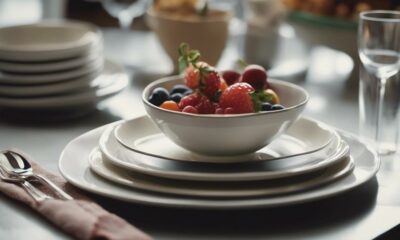
 Tableware and Dining Accessories7 months ago
Tableware and Dining Accessories7 months agoWhat Is the Meaning of the Word Tableware
-

 Tableware and Dining Accessories7 months ago
Tableware and Dining Accessories7 months agoWhen Is Tableware on Sale at Hobby Lobby
























